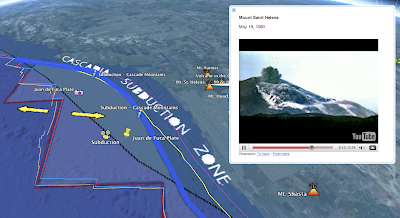 Every region of the Earth is paragraph in the textbook. The Pacific Northwest - Cascade Mountain Range is a paragraph. Iceland and the Mid-Atlantic Ridge is a another paragraph and so is the Mariana Trench.
Every region of the Earth is paragraph in the textbook. The Pacific Northwest - Cascade Mountain Range is a paragraph. Iceland and the Mid-Atlantic Ridge is a another paragraph and so is the Mariana Trench.All the placemarks that have been deliberately created are sentences (I created them in Google My Maps). Every YouTube video, every image and every word is helping to tell the story and emphasize the main idea.
Although I spent a lot of time putting the content together, I could finally sit back in (not really) in class and watch the students take it in at their own pace. If a student wanted more, we turned on the Wikipedia or volcano layer. If a student was struggling, we focused on the videos. Easy!
This book is different than the ones I never use in the class. It is dynamic. Almost every class period used different KML file because I would discover errors or glitches and correct them for next class. It is differentiated. The content can easily be adjusted based on the learner. It is also chalked full of media. I heard an NPR story about curiosities at the bottom of the Mariana Trench and the next day students were watching relevant YouTube videos of the only liquid sulfur cauldron this side of Jupiter. That wasn't known when my textbook was published.
Just saying. Thoughts?
Click here for the most recent version of the Plate Tectonics KML file.
This looks incredible! I was just sitting down to create a plate tectonics lesson in Google Earth. Would you be willing to share your lesson plan and KML file?
ReplyDelete